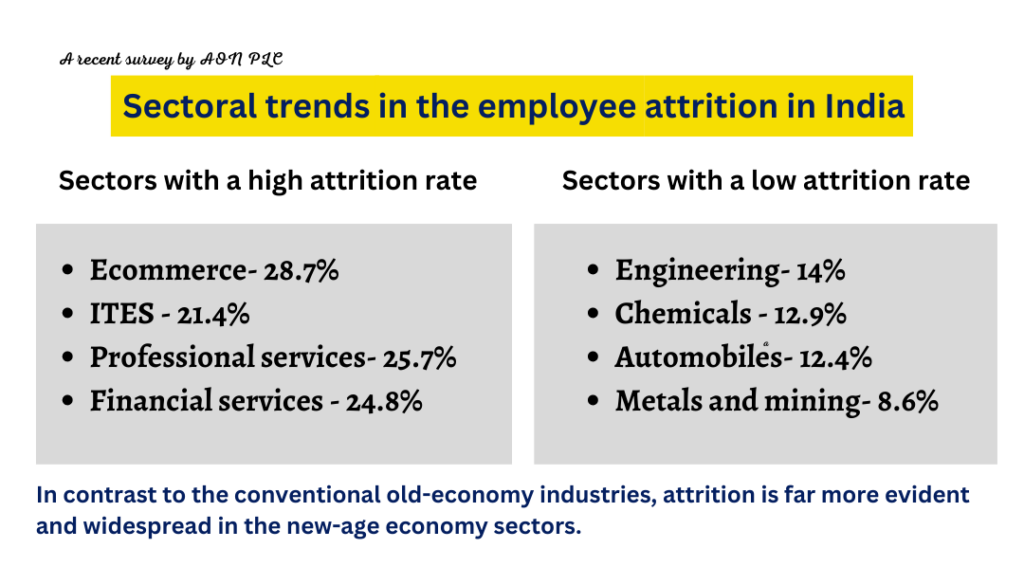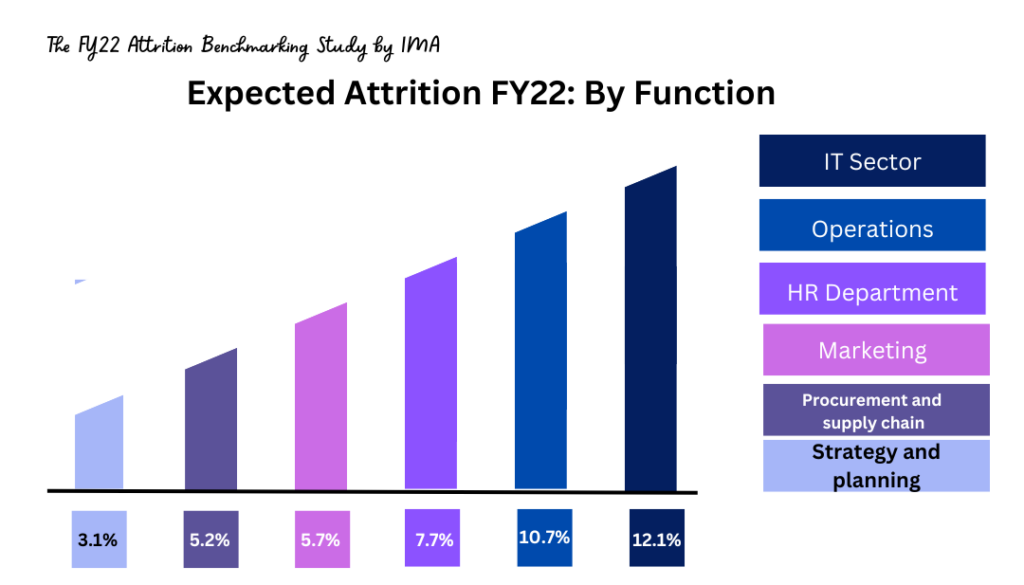What is Attrition?
Employee attrition is a term used in the Human Resource System to refer to the gradual losses of employees from an organization. It can be due to various reasons, including employees leaving for better opportunities, retirement, health issues, or job dissatisfaction. Employee attrition is a natural part of running any business, but it can be costly in terms of time and money spent on recruiting, training, and developing new employees.

Attrition can broadly be categorized into two parts:
Voluntary attrition
Voluntary attrition is when an employee chooses to leave the organization on their own accord. Factors such as poor worker’s management, a desire to pursue a different career path, a better job offer from another employer, or simply a lack of interest in the current job are responsible for voluntary attrition.
Involuntary attrition
Involuntary attrition is when an employee is forced to leave the organization due to circumstances beyond their control, such as a layoff or termination. Organizations must keep track of voluntary attrition rates, as it can indicate a need for improvement. Involuntary attrition is generally caused by downsizing, restructuring, or budget cuts. It can also occur if an employee does not meet the company’s performance expectations or if the employee’s position is no longer necessary.

Top reasons responsible for worker attrition
- Unsatisfactory working conditions
Unsatisfactory working conditions are a significant factor in employee attrition. Working conditions such as unsafe working environments, lack of job security, long hours, poorly designed workspaces, and uncomfortable temperatures can make employees feel unmotivated. It further prompts employees to search for jobs that meet their standards.
Employees who experience substandard working conditions become dissatisfied with their job and feel that company is unable to meet their needs. Unsatisfactory working conditions can also lead to elevated levels of stress and burnout, as managers push employees too hard and ask them to do more than they can realistically handle. These negative experiences can ultimately cause employees to leave the organization for a better working environment.

- Lack of career advancement opportunities
One of the most common reasons for employee attrition is a lack of career advancement opportunities. When employees feel that their career progress is stagnant and there are no opportunities for growth, they feel disheartened and start looking for other positions elsewhere.
Career advancement opportunities can include promotions, job enrichment, and more. Without these opportunities, employees become dissatisfied and move on to a different company that can offer more potential for career progression. When employers provide career advancement opportunities, they show that they invest in their development and growth. It can increase employee engagement, and loyalty, resulting in lower attrition rates. Employers should also consider providing additional training and development opportunities for employees to help them grow professionally.
Training helps them advance in their current roles and provides them with the skills needed to assume higher-level positions. Lack of career advancement opportunities can lead to employee attrition, which can be costly for businesses. Employers should ensure they continually provide employees opportunities to grow in their careers to reduce attrition.
- Poor management and leadership
Poor management and leadership result from a lack of direction, vision, and clarity to run an organization. It leads to miscommunication, lack of motivation, decreased productivity and profitability, and ultimately employee attrition. Poor management and leadership can affect all aspects of an organization, from the top down to the bottom.
At the top level, poor management and leadership can result in a lack of strategic planning and decision-making, leading to inefficient use of resources and missed opportunities for growth. Poor decision-making also prevents an organization from reacting quickly to changes in the external environment, such as technological advances or shifts in customer preferences.
At the lowest level, poor management and leadership can result in an unorganized work environment, resulting in confusion and a lack of focus among employees.
Poor management and leadership can also lead to a lack of accountability and failure to meet goals or objectives. Additionally, poor management and leadership can create an environment of mistrust and a lack of respect between managers and their employees. This ultimately leads to dissatisfaction and a lack of employee commitment, resulting in higher absenteeism and, eventually, resignation.
- Lack of recognition and appreciation
Lack of recognition and appreciation from an organization can greatly affect employee morale, motivation, and productivity. In addition, employees who don’t receive appreciation or recognition are more likely to leave the organization due to dissatisfaction. Organizations that fail to recognize and appreciate their employees’ hard work and dedication are likely to suffer in terms of performance and culture. Additionally, a culture of non-recognition and non-appreciation can negatively impact an organization’s reputation, making it difficult to attract and retain talented employees. It can lead to lower productivity, increased absenteeism, and a higher attrition rate.
Studies have found that recognition and appreciation can have a significant positive effect on employee performance. Employees who experience frequent recognition and appreciation are more dedicated to their work and have greater job satisfaction. In addition, they are more motivated to contribute to their team’s success, resulting in higher quality work, better customer service, and improved organizational performance.
Acknowledging and rewarding employees for their hard work and dedication helps create a positive organizational culture and reduces employee turnover.
- Unattractive salary and benefits
Unattractive salaries and benefits are one of the major reasons for employee attrition. It includes:
- Low salaries.
- Limited bonus or incentive structures.
- Inadequate vacation time.
- Lack of health insurance or other benefits.
- Lack of performance recognition or rewards.
Studies have found that salary is often the primary factor driving employee retention. When companies do not adequately compensate employees for their work, it can lead to low morale, dissatisfaction, and a lack of motivation. In addition, employees who feel they are not receiving fair compensation are less likely to stay with the company and may even be vocal about their frustrations. Ultimately this can increase employee turnover as employees start to look for new opportunities that provide better payroll management, competitive salary, and benefits.
Additionally, employers who offer lower salaries and fewer benefits may find it difficult to attract top talent, leading to high turnover rates. In addition to the financial impact, unattractive salaries and benefits can significantly affect employee engagement. Finally, unattractive salary packages and benefits can create an atmosphere of distrust and resentment between employees and management. That’s why it is so important for employers to offer attractive salary and benefits packages to retain their best employees.

- Unhealthy work-life balance
An unhealthy work-life balance is an imbalance between personal and professional responsibilities, resulting in a lack of time for rest and leisure activities. It increases stress, fatigue, and anxiety, negatively affecting an employee’s work performance..
Unhealthy work life involves:
- Long working hours
- Lack of time off
- Long commutes
- Overwork
- Underappreciation.
Unhealthy work-life balance happens due to various issues, including stress, burnout, depression, physical illness, and decreased job satisfaction. It can also lead to higher employee turnover, as employees may feel they must leave their current job to balance their work and personal lives better. The effects of an unhealthy work-life balance on employee attrition can be significant.
How does employee attrition affect an organization?
The effects of employee attrition can vary depending on the size and nature of the organization, but it generally has a negative impact on productivity, morale, and costs. When employees leave their positions, the organization must spend time and money to hire and train replacements. This process is often time-consuming and costly, which can disrupt business operations.
Difficulty in meeting customer demands
Employees who have worked at the organization for longer may have specialized knowledge and skills that are difficult to replace. When customers notice a decline in the quality of service or product they receive, it can lead to a decrease in customer loyalty and trust. It significantly damages the business’s reputation, reducing sales and profits. Additionally, when customers see high levels of employee turnover, it can make them question the stability of the business and its ability to provide consistent service. As a result, organizations may struggle to meet customer demands or complete new projects.
Reduced morale among remaining employees
Employee attrition can also damage employee morale since the remaining staff must often take on extra responsibilities to fill the gaps left by departed employees. This increased workload can cause stress and resentment among team members, leading to further attrition.

Attrition can be expensive for employers, as they must incur costs for severance packages, recruitment, and training. These additional costs can put a strain on an organization’s finances, leading to decreased profits and a weakened competitive position.
Loss of institutional knowledge and experience
When employees leave, they take valuable knowledge and experience that can be difficult to replace. Here employee management is essential to ensure the smooth functioning of an organization by ensuring proper onboarding and training of new hires so that their impact on the organization won’t be too disruptive.
Difficulty in recruiting and retaining top talent
Attrition can lead to recruitment and retention difficulties if organizations cannot replace departing employees with equally skilled and capable replacements. Recruiting and retaining talented employees requires considerable resources, money, and time. When organizations cannot replace departing employees on time, they may find filling positions with qualified personnel difficult. Furthermore, when attrition rates are high, the demand for qualified personnel may be greater than the available supply, resulting in a skills gap and higher recruitment costs.
Loss of customer confidence
Employees leaving their positions can be disruptive and create customer uncertainty leading to a lack of trust in the organization. Customers start feeling a decline in quality due to the lack of continuity. And new employees may not be up to speed with the same level of expertise as their predecessors, which can lead to a loss of customer confidence in the service.
Increase in labor costs and decreased productivity
Employee attrition can have a significant impact on labor costs and productivity. When employees leave, employers have to invest in recruiting and hiring new workers and training them to become productive. This process can be costly and time-consuming, resulting in decreased productivity and increased labor costs.
Strategies to combat Employee attrition
Employee attrition is a major concern; organizations must address it effectively to ensure success. It is important to understand the underlying causes of employee attrition and devise strategies to combat it. Let’s go through some of the effective strategies.
- One of the most effective strategies to combat employee attrition is having an efficient employee database management system. This system should include an employee profile, a performance management system, and a leave management system. It will help organizations identify and address employee issues, thereby preventing attrition.
- Another strategy to combat employee attrition is to ensure that employees are adequately trained and developed for their roles. Companies can offer relevant training opportunities and provide mentorship programs to employees. It will help employees understand their roles better and be equipped with the necessary skills to perform their tasks efficiently. It will also help to motivate employees and create a sense of job satisfaction.
- Organizations should also strive to create a positive work culture where employees feel valued and appreciated. Providing recognition for employees’ work and encouraging employee engagement can make this possible.
- Companies should also focus on providing employees with a safe and secure work environment. It will create a sense of security among employees and make them feel that their needs are being taken care of.
- Lastly, organizations should also focus on providing competitive salaries and benefits to employees. It will ensure that employees are sufficiently compensated for their work and are encouraged to remain with the organization.
How can HRMS software help in reducing the employee attrition rate in an organization?
HRMS software can monitor and track employee attrition, enabling organizations to understand better the factors causing the attrition and create strategies to reduce the attrition rate.
HRMS software can help organizations analyze their employee attrition rate and identify trends or patterns leading to employee attrition. This data can identify areas where the organization could lose employees and make necessary changes to improve the employee experience.
Companies can also use HR software to keep track of employee records, such as hiring, training, and performance. In addition, HRMS software can create and analyze surveys that provide insight into why employees are leaving and what the organization can do to improve employee retention. Organizations need to understand the causes of attrition to manage employee attrition and take steps to reduce it effectively.
In addition to tracking employee attrition, HRMS software can keep track of employee performance and engagement. By gathering data on employee performance and engagement, organizations can better understand which employees are most likely to leave. This can reduce employee attrition and ensure that the organization has the most qualified and experienced employees available.
Organizations can also use this software to create incentives to help retain employees. These programs can also include career development, recognition, and rewards for employees. With the right HRMS software, organizations can ensure that they have the right people in the right positions and that employees are happy and motivated to stay.
Conclusion
In conclusion, having an efficient employee database management system, providing training and development opportunities, creating a positive work culture, encouraging employee engagement, and providing competitive salaries and benefits are some key strategies to combat employee attrition. Implementing these strategies would help organizations to ensure a motivated and engaged workforce.


